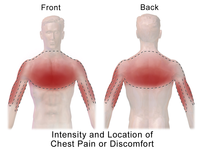
Photo from wikipedia
Portable bedside chest X-ray (CXR) is an important and frequently used tool in the intensive care unit (ICU). Unfortunately, the diagnostic value of portable CXR is often low due to… Click to show full abstract
Portable bedside chest X-ray (CXR) is an important and frequently used tool in the intensive care unit (ICU). Unfortunately, the diagnostic value of portable CXR is often low due to technical limitations and suboptimal patient positioning. Additionally, abnormalities in the chest may be hidden on the projection image by overlapping anatomy and devices such as endotracheal tubes, lines and catheters. Digital tomosynthesis (DTS) can solve the problem of anatomical overlap. In DTS, several low-dose X-ray images from different angles are acquired and subsequently used by a reconstruction algorithm to compute section images along planes parallel to the detector. However, a portable device to be used for portable bedside chest DTS is not on the market yet. In this work, we discuss modifications to a portable X-ray device to enable portable DTS and illustrate the potential of portable DTS to improve the diagnostic value of bedside CXR in the ICU. A simulation, based on computed tomography scans, is presented. Our experiments comparing portable DTS with conventional bedside CXR showed a substantially improved detection of pneumothorax and other abnormalities.
Journal Title: European Radiology Experimental
Year Published: 2017
Link to full text (if available)
Share on Social Media: Sign Up to like & get
recommendations!